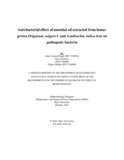| dc.contributor.advisor | Bin Naser, Dr. Iftekhar | |
| dc.contributor.author | Prapti, Jarin Tusnim | |
| dc.contributor.author | Sumaiya, Kazi | |
| dc.contributor.author | Maliha, Farhat | |
| dc.date.accessioned | 2023-05-08T09:25:27Z | |
| dc.date.available | 2023-05-08T09:25:27Z | |
| dc.date.copyright | 2022 | |
| dc.date.issued | 2022-10 | |
| dc.identifier.other | ID: 17136016 | |
| dc.identifier.other | ID: 17336006 | |
| dc.identifier.other | ID: 17336009 | |
| dc.identifier.uri | http://hdl.handle.net/10361/18244 | |
| dc.description | This thesis is submitted in partial fulfillment of the requirements for the degree of Bachelor of Science in Biotechnology 2022. | en_US |
| dc.description | Catalogued from PDF version of thesis. | |
| dc.description | Includes bibliographical references (pages 59-65). | |
| dc.description.abstract | Antibiotic resistance has been on the rise for many years now. Multidrug resistance patterns in Gramnegative and Gram-positive bacterial strains are difficult to cure and might even be untreatable with
conventional synthetic antibiotics. Furthermore, there is a shortage of novel antibiotics in the market.
Therefore, to combat global health crisis, development of new treatment options and alternative
antimicrobial therapies, preferably from natural sources, are essential.
Oregano (Origanum vulgare L) essential oil (OEO) is known to have antibacterial properties and
this study was aimed to find its ability to inhibit the growth of some infectious bacterial strains and
also do a comparative analysis with a well-known antibacterial oil; Neem (Azadirachta indica)
essential oil. This study on antibacterial activity against selected pathogens was carried out using
Kill-time and Dosage dependent spread plate method. Klebsiella pneumonia, shigella, STEC,
Salmonella typhi, Aeromonas hydrophila, Staphylococcus aureus and Enterococcus faecalis was
selected for this study.
The study showed the average percentage inhibition of each oil is directly proportional with the
dosage. OEO showed greater antibacterial activity against the bacterial strains as compared to
NEO. For 50µl dosage the average inhibition rate for OEO was 73.3% and for NEO it was only
45.9%. NEO was less effective on bacterial strains; Klebsiella pneumonia, Shigella, Aeromonas
hydrophia, STEC, Staphylococcus aureus and Enterococcus faecalis as compared to OEO. The
only bacterial strain NEO was more effective on was Salmonella typhi. OEO demonstrated 100%
inhibition against Klebsiella pneumonia, Shigella, Aeromonas hydrophila, STEC, Staphylococcus
Aureus and Enterococcus faecalis at varying dosage of oil. Whereas, NEO showed 100%
inhibition against Salmonella typhi and Staphylococcus Aureus at 150µl and 200µl dosage of oil
respectively. | en_US |
| dc.description.statementofresponsibility | Jarin Tusnim Prapti | |
| dc.description.statementofresponsibility | Kazi Sumaiya | |
| dc.description.statementofresponsibility | Farhat Maliha | |
| dc.format.extent | 70 pages | |
| dc.language.iso | en | en_US |
| dc.publisher | Brac University | en_US |
| dc.rights | Brac University theses are protected by copyright. They may be viewed from this source for any purpose, but reproduction or distribution in any format is prohibited without written permission. | |
| dc.subject | Antibiotic resistance | en_US |
| dc.subject | Origanum vulgare L | en_US |
| dc.subject | OEO | en_US |
| dc.subject | Azadirachta indica | en_US |
| dc.subject.lcsh | Pathogenic bacteria. | |
| dc.title | Anti-bacterial effect of essential oil extracted from homegrown Origanum vulgare L and Azadirachta indica tree on pathogenic bacteria | en_US |
| dc.type | Thesis | en_US |
| dc.contributor.department | Department of Mathematics and Natural Sciences, Brac University | |
| dc.description.degree | B. Biotechnology | |

